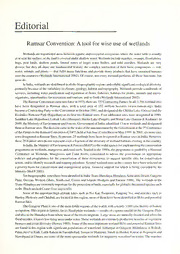
Ramsar Convention: a Tool for Wise Use of Wetlands PDF
Preview Ramsar Convention: a Tool for Wise Use of Wetlands
Editorial A Ramsar Convention: tool for wise use of wetlands Wetlands are transitional areasbetween aquatic andterrestrialecosystems where the watertable isusually atornearthesurface,orthelandiscoveredundershallowwater.Wetlandsincludemarshes,swamps,floodplains, bogs, peat lands, shallow ponds, littoral zones of larger water bodies, and tidal marshes. Wetlands are very — diverse, but they all share—one fundamental feature: the complex interaction oftheir basic components soil, water, animals and plants that fulfil many functions and provide many products that have sustained humans overthecenturies (Wetlands International 2002). Ofcourse, not every wetland performs all these functions, but most do. InIndia,wetlandsaredistributedinallthebiogeographicregionsandexhibitsignificantecologicaldiversity, primarilybecauseofthe variability inclimate, geology, habitatandtopography.Wetlandsprovide amultitude of services, including waterpurification and regulation offlows, fisheries, habitats for plants, animals and micro- organisms, opportunities forrecreation andtourism, andsoforth (Wetlands International 2002). TheRamsarConventioncameintoforcein 1975;thereare 157ContractingParties.Inall, 1,704wetlandsites have been designated as Ramsar sites, with a total area of 152 million hectares (www.ramsar.org). India becameaContracting PartytotheConventioninOctober 1981, anddesignatedtheChilikaLake(Orissa)andthe Keoladeo National Park(Rajasthan) as its firsttwo Ramsarsites. Fouradditional sites were designated in 1990: SambharLake(Rajasthan),LoktakLake(Manipur),HarikeLake(Punjab),andWularLake(Jammu& Kashmir). In 2000,the MinistryofEnvironmentandForests,GovernmentofIndia, identified 13 new wetlandsanddesignated themasRamsarsites.ThedecisioncameinthewakeoftheannouncementbytheGovernmentatthe7"’Conference ofthePartiestotheRamsarConvention(COP7)heldatSanJose(CostaRica)inMay 1999. In2005,sixmoresites weredesignatedasRamsarSites.Atpresent,25wetlandshavebeendesignatedasRamsarsitesinIndia. However, these25 Ramsarsitesdonotrepresentevenafractionofthediversity ofwetlandhabitatsexisting in thecountry. InIndia,theMinistryofEnvironment&Forests(MoEF)isthenodalagencyforimplementingtheconservation programmeonwetlands,mangrovesandcoral reefs. Startedinthe 1980s,theprogrammeisguidedby aNational Committee on Wetlands, Mangroves and Coral Reefs, constituted to advise the government on appropriate policies and programmes for the conservation of these ecosystems, to suggest specific sites for conservation action, andtoidentifyresearchandtrainingpriorities. Several wetlandsitesin thecountry havebeen selectedon a priority basis for conservation and management action, financial support for which is being extended by the Ministry(MoEF2001). TenbiogeographiczoneshavebeenidentifiedinIndia:Trans-Himalaya,Himalaya,Semi-arid,Desert,Gangetic Plain, Deccan, Western Ghats, North-east, Coasts and Islands (Rodgers and Panwar 1988). The wetlands in the Trans-Himalayaareextremelyimportantfortheprotectionofbirds,especiallyforgloballythreatenedspeciessuch asthe Black-neckedCrane Grusnigricollis. Some ofthe important high altitude lakes such as Tso Kar, Tsomoriri, PangongTso, and marshes such as Hanley,PhoktseyandChushul,arelocatedinthisregion;mostofthemhavebeenidentifiedasIBAsandpotential RamsarSites. TheGangeticPlainisoneofthemostfertileregionsofth—eworld,withanearly3,000yearhistoryofhuman occupation. Thisregionisfamous foritsfloodplain wetlands resultsofcopious rainfall in the Gangetic Plain and also inthe Himalayafrom where mostoftheriversoriginate. Large areasareannually floodedand when the floodrecedes,itleaveslow-lyingareasunderwater.Thesewetlandsareextremelyproductiveintermsofvegetation biomassandaviandiversity(Howes 1995). Someofthe mostimportantwetlandIBAsandpotentialRamsarSites are found in this region with significant populationsofwaterfowl. Sultanpurin Gurgaon, Bhindawas in Rohtak, Patnajheelin Etah, Lakh-Bahosi in Farrukhabad, Saman in Mainpuri, Sandi in Hardoi, Kawarin Begusarai and Nawabganj inUnnao, aresomeofthemore spectacularwetlandsformigratory waterfowl inwinter.Themarshes . and wetlands ofthe Gangetic drainage system show a long history ofstability in the geological sense. Thus, a large number of marsh-dependent species are found such as the Striated Marsh Warbler Megaluruspalustris , BristledGrassbirdChaetornisstriatus,Rufous-rumpedGrassbirdGraminicolabengalensis Yellow-belliedPrinia , Prinia flaviventris, Swamp Francolin Francolinus gularis, Bengal Florican Houbaropsis bengalensis and a variety ofducks. The flood plains ofthe Brahmaputra and the marshes and swamps in the hills ofnorth-east India and the Himalayanfoothillsareimportantforhumansandbiodiversity.TheBrahmaputraValley,withitshighrainfalland numerous rivers provide wintering grounds to large congregations ofwaterbirds. Most ofthese waterbirds are migratory while some are resident and breed in this region. The wetlands of this region support a number of threatened species; anumberofIBAs and potential RamsarSites have been identifiedin thisregion. IntheRannofKutchinGujarat, vastsalineexpansesarefoundwherebothGreaterPhoenicopterusroseus andLesserP. minorflamingosbreedwhenconditionsaresuitable.ThewetlandsoftheDeccanpeninsulasupport ahighproportionoftheglobal populationofthe Spot-billedPelicanPelecanusphilippensis withmanycolonies , associatedwiththewaterstoragereservoirsor ‘tanks’ onthe DeccanplateauinsouthernIndia.Thecoastalareas ofIndiaperhapsformthemostneglectedbiogeographiczoneofIndia,mainlybecausetheydonothavecharismatic species such as theTigerand the Rhinoceros. However, they dohave fabulousbirdcongregations, as seen inthe ChilikaLake(IBAandRamsarSite)andBhitarkanika(IBAandRamsarSite)inOrissa,thePointCalimereWildlife Sanctuary(IBAandRamsarSite)inTamilNadu,theSunderbans(IBAandRamsarSite)inWestBengal,theSewri mudflats(IBAandpotential RamsarSite)inMaharashtraandtheKoriCreekinGujarat. Theexisting Ramsarsitelistof25 sitesin Indiaclearlyprovesthatallthebiogeographical regionsofIndia arenotproperlyrepresented,andsomeofthepotentialsitesaremissing,e.g. manyimportantsitesintheGangetic Plain, North-east, Semi-Arid, DesertandDeccan. Underthe Important BirdAreas Programme ofthe BNHS and BirdLife International we havepreparedalistofadditional 135 wetlandswhich are potential RamsarSites. This exercise is done objectively taking into consideration IBA and Ramsar criteria. We have identified potential RamsarSitesmainlybasedontheirbiodiversityvalues,whichwastheoriginalaimoftheRamsarConvention. We have also tried to coverthe whole country and all biogeographic regions and theirprovinces. WehopethatmanyofthesepotentialsiteswillbeconsideredbytheGovernmentofIndiaundertheRamsar Convention. ASAD RAHMANI R. ZAFAR-ULISLAM REFERENCES Ui Howes, J.R. (1995): Conservation and Sustainable Use ofFloodplain Wetlands. Asian Wetland Bureau, Kaula Lumpur, 123 pp. (ProceedingsoftheWorkshopon theConservation and SustainableUseofFloodplainWetlands, December 1993,Calcutta -AWB Publication No. 113). Ministry ofEnvironmentand Forests (2001): State Forest Report 2001. Forest Survey ofIndia, Dehradun. Rodgers, W.A. & H.S. Panwar (1988) Planning a Protected Area Network in India. 2 volumes. Wildlife Institute of India, Dehradun. Wetlands International (2002): Waterbird Population Estimates: Third Edition. Wetlands International Global Series No. 12, Wageningen, The Netherlands. 126 J. Bombay Nat. Hist. Soc., 104 (2), May-Aug 2007
